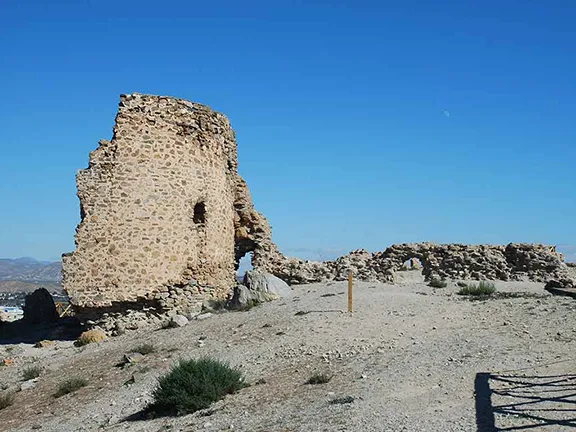On the eastern edge of the Desierto de Tabernas, in a dry gulch sandwiched between the Sierra de los Filabres and the Sierra Alhamilla is the Almerian town of Tabernas
By Nick Nutter | Updated 5 Mar 2022 | Almería | Villages |
Login to add to YOUR Favourites or Read Later


Tabernas castle
Tabernas – what does the name suggest to you? Spaghetti westerns, the ‘Man With No Name’, ‘The Good, The Bad and The Ugly’, the haunting music of Italian composer Ennio Morricone – all that and more. Sure, nearby you can visit the film sets used in the production of those westerns and the ramblas where, more recently, the series ‘Game of Thrones’ was filmed. Most people make directly for Oasys Mini Hollywood, Western Leone or Fort Bravo. Many are missing a trick by not visiting the village of Tabernas itself where real life dramas have been enacted and the lifestyle is not so different to that of the fictional characters portrayed in films.


Tabernas bullring
On the eastern edge of the Desierto de Tabernas, in a dry gulch sandwiched between the Sierra de los Filabres to the north and the Sierra Alhamilla to the south, is the Almerian town of Tabernas.


Iglesia Parroquial de Ntra. Sra. de la Encarnación Tabernas
Overlooking the town is the 11th century, Muslim, Castillo de Tabernas. Built from the honey-coloured sandstone native to the area, the castle originally occupied an area of almost 3000 square metres and during the Nazrid period was considered to be the second most important citadel or alcazabar in Almeria, the most important being in Almeria city. In 1489, the Catholic Monarchs, Ferdinand and Isabella, stayed there on a number of occasions as they bustled around the area reconquering Almeria and Granada.


Solar farm
By the early 16th century, the castle was a ruin and the monarch, Carlos V, was moved to have it repaired in response to the growing threat of attack by Barbary pirates. The threat materialised in 1566 when a powerful pirate force landed near Agua Amarga in the Cabo de Gata. In the early hours of the 24th September they plundered Tabernas and took 55 Christians as slaves before heading off to raid Carboneras.


Tabernas town view
Only two years later, in 1568, the castle was again in action. This time during the Rebellion of the Alpujaras, the Moorish uprising. The castle was assaulted by 200 Moors under the leadership of Garcia el Zaucar, el Nagüar and el Bayzi de Gergal. In 1570, towards the end of the uprising, the infamous illegitimate son of Carlos, Don Juan de Austria, expelled the Moors from the castle and surrounding area and ordered the castle sealed up.


Tabernas castle
The town of Tabernas was repopulated by Christian families from outside the area and by the middle of the 18th century had a population of 2,569, a number not greatly exceeded today. The town that you see today largely stems from this period. Square, flat-roofed houses, many of them whitewashed, crammed together for mutual support, sprawl outwards from beneath the hill on which the ruined castle stands. In the middle of this confusion of housing, the Mudejar style church, built in the 16th and early 17th centuries, stands aloof. Its tall, square tower, typical of this period is a landmark from anywhere in the town. Tabernas enjoyed a brief period of prosperity during the late 19th and early 20th centuries when the lead mines of the Sierra Alhamilla were working. The population increased and then after the 1960s fell back to the pre-boom levels.
Ideally suited to the desert environment, Tabernas appears to crouch, lifeless, beneath the heat of the noonday sun and would not look out of place in 19th century Mexico or Texas.
Growing olive trees and producing olive oil is the main industry. Castillo D’ Tabernas oil is renowned for its low acidity, brought about by the intense sunlight under which the trees grow and the over 3,000 hours of sunlight they receive each year. On a personal note, Tabernas is my favourite oil, I generally have a bottle of Green Olive, Arbequina and one of Coupage to hand.
The 3,000 plus hours of sunlight encouraged the Centre for Environmental and Technological Energy Research and the DLR German Aerospace Research Centre to establish the Almería Solar Platform. This is the world’s largest solar research centre and is visited by research groups and tourists who are treated to first-hand knowledge of technical developments in solar energy and its applications. The production of photovoltaic electrical energy is only one application, the centre also looks at solar desalination, solar water treatment and energy efficiency in buildings.
Today, Tabernas is synonymous with the western films that have made the place famous. Strangely enough, Tabernas was getting a name for itself over two thousand years ago. The name is thought to derive from the Greek word Thabernax. Parts of the Almeria coast were visited by Greek traders; Mojacar for instance was the Greek settlement of Murgis-Akra. Thabernax was a place of refreshment, a collection of whorehouses, taverns and inns put there for the convenience of the passing Greek legions. I can imagine Thabernax being as welcome a sight for the thirsty Greek foot soldier as Tabernas is today for the thirsty tourist.